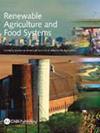Estimation of short- and long-term floor and ceiling prices for manure in a crop and livestock farms exchange
IF 2
3区 农林科学
Q2 AGRICULTURE, MULTIDISCIPLINARY
引用次数: 1
Abstract
Abstract Organic matter is a key element of soil fertility. However, in-soil stocks of organic matter are in decline in specialized crop farms. Reintroducing organic fertilizers could be a way to increase or at least maintain organic matter stocks in these soils. Straw/manure exchanges between crop farms and livestock farms could improve overall land fertility and thus the long-term income of farmers. Here we used a bioeconomic model to estimate the agronomic and economic benefits of straw/manure exchanges as part of a strategy to improve soil fertility. Iterative simulations were run with prices of farmyard manure varying from €0 to €20 ton−1 to identify the price at which a crop farm can buy manure and sell straw without degrading its net income (manure ceiling price) compared to purchasing mineral fertilizer only and ploughing back straw. Parallel simulations were run to identify the price at which a livestock farmer can sell manure and buy straw without degrading its net income (manure floor price) compared to keeping all manure on the farm and buying straw on the market. The key new contributions of this study are that it (i) considers the characteristics of manure beyond its short-term fertilizing value, i.e., better mineralization of humus and a 10% increase in crop yields, (ii) estimates both the economic and agronomic benefits of manure and (iii) assesses the impacts of uncertainties on manure effects and prices. The results show that it is profitable for a French farmer in a conventional field crop system to buy manure at a price between €10 ton−1 in the short term and €18 ton−1 in the long term. The results also show that it is still economically advantageous for a livestock farmer to sell part of their manure, even at a very low price. This study shows that it is possible to better distribute manure resources over a territory in a way that enriches the soils of crop farms without degrading the soils of livestock farms.作物和畜牧场交换中粪肥的短期和长期最低和最高价格的估计
摘要有机质是土壤肥力的关键因素。然而,在专业作物农场,土壤中的有机物储量正在下降。重新引入有机肥料可以增加或至少保持这些土壤中的有机物储量。作物农场和畜牧场之间的秸秆/粪肥交换可以提高整体土地肥力,从而提高农民的长期收入。在这里,我们使用了一个生物经济模型来估计秸秆/粪肥交换的农艺和经济效益,作为提高土壤肥力战略的一部分。迭代模拟是在农家肥价格从0欧元到20欧元的情况下进行的,以确定与只购买矿物肥料和翻耕秸秆相比,作物农场可以在不降低净收入的情况下购买肥料和出售秸秆的价格(肥料最高价格)。进行了平行模拟,以确定畜牧业农民在不降低其净收入(粪肥底价)的情况下出售粪肥和购买秸秆的价格,与将所有粪肥留在农场并在市场上购买秸秆相比。这项研究的关键新贡献是,它(i)考虑了肥料的短期施肥价值之外的特性,即腐殖质的矿化更好,作物产量增加10%,(ii)估计了肥料的经济和农艺效益,以及(iii)评估了不确定性对肥料效应和价格的影响。结果表明,在传统的田间作物系统中,法国农民以短期10吨-1欧元至长期18吨-1欧元的价格购买肥料是有利可图的。研究结果还表明,即使以很低的价格出售部分粪便,对畜牧业农民来说仍然具有经济优势。这项研究表明,在不退化畜牧场土壤的情况下,可以更好地在一个地区分配肥料资源,丰富作物农场的土壤。
本文章由计算机程序翻译,如有差异,请以英文原文为准。
求助全文
约1分钟内获得全文
求助全文
来源期刊

Renewable Agriculture and Food Systems
农林科学-农业综合
CiteScore
5.20
自引率
7.40%
发文量
39
审稿时长
>36 weeks
期刊介绍:
Renewable Agriculture and Food Systems (formerly American Journal of Alternative Agriculture) is a multi-disciplinary journal which focuses on the science that underpins economically, environmentally, and socially sustainable approaches to agriculture and food production. The journal publishes original research and review articles on the economic, ecological, and environmental impacts of agriculture; the effective use of renewable resources and biodiversity in agro-ecosystems; and the technological and sociological implications of sustainable food systems. It also contains a discussion forum, which presents lively discussions on new and provocative topics.
 求助内容:
求助内容: 应助结果提醒方式:
应助结果提醒方式:


